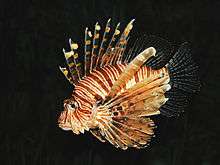Pterois miles
Pterois miles, the devil firefish or common lionfish, is a species of ray-finned fish native to the western Indo-Pacific region. It is frequently confused with its close relative, the red lionfish (Pterois volitans). The scientific name is from Greek pteron, meaning "wing", and Latin miles, meaning "soldier".
| Pterois miles | |
|---|---|
 | |
| Scientific classification | |
| Kingdom: | Animalia |
| Phylum: | Chordata |
| Class: | Actinopterygii |
| Order: | Scorpaeniformes |
| Family: | Scorpaenidae |
| Genus: | Pterois |
| Species: | P. miles |
| Binomial name | |
| Pterois miles (J. W. Bennett, 1828) | |
Description
The common lionfish grows up to 35 cm (14 in) in length. The dorsal fin has 13 long, strong spines and 9-11 soft rays, and the anal fin has three long spines and six or seven soft rays. The dorsal fin appears feathery and the pectoral fins are wing-like with separate broad, smooth rays. These fish vary in colour from reddish to tan or grey and have numerous thin, dark, vertical bars on their heads and bodies.[2] Its head is less angular than that of P. volitans.
Behaviour
The common lionfish is mainly nocturnal and hides in crevices during the daytime. It feeds on fish and small crustaceans. It has few predators, probably because of its venomous spines, but larger lionfish do prey on smaller ones. The bluespotted cornetfish (Fistularia commersonii) has been shown to feed on it, as also do groupers in the Bahamas.[3]
Distribution and habitat
P. miles is native to the Indian Ocean, from the Red Sea,[4] to South Africa, and to Indonesia; it has also recently been reported in the eastern and central Mediterranean Sea, near Cyprus, in Malta,[5] north up to İzmir in the Aegean Sea (Lessepsian migration) . It is also now present off the east coast of the United States and in the Caribbean Sea where is regarded as an invasive species.[3] It is very similar in appearance to P. volitans, which does not occur in the Red Sea. P. miles is usually found in areas with crevices or lagoons, often on the outer slopes of coral reefs.[6] Moray eels have recently been identified as natural predators of P. miles in its native habitat in the Red Sea.[7] Some grouper species and reef sharks are also its predators.
Hazards
| Wikimedia Commons has media related to Pterois miles. |
The fin spines are highly venomous and have caused death to humans.[2]
Gallery
- Common lionfish near Dunraven wreck (Red Sea)
- Common lionfish hunting glassfish at El Mina wreck (Red Sea)
- Common lionfish at Sataya reef (Red Sea)
- Common lionfish at Shaab Angosh reef (Red Sea)
References
- Motomura, H., Matsuura, K. & Khan, M. 2018. Pterois miles . The IUCN Red List of Threatened Species 2018: e.T190475A54145413. http://dx.doi.org/10.2305/IUCN.UK.2018-2.RLTS.T190475A54145413.en. Downloaded on 14 December 2019.
- "Pterois miles, Devil firefish". Fishbase.org. 2012-07-03. Retrieved 2013-04-08.
- Schofield, P J; Morris, J A Jr; Langston, J N; Fuller, P L (2012-09-18). "Lionfish: Pterois volitans/miles". Nonindigenous Aquatic Species. USGS. Retrieved 2013-12-20.
- Bos A.R., J.R. Grubich, A.M. Sanad (2018). "Growth, site fidelity and grouper interactions of the Red Sea Lionfish, Pterois miles (Scorpaenidae) in its native habitat". Marine Biology. 165 (10): 175. doi:10.1007/s00227-018-3436-6.CS1 maint: multiple names: authors list (link)
- "University Research Discovers New Alien Species In Maltese Waters". Malta Today. 2016.
- Siliotti, A. (2002) fishes of the red sea Verona, Geodia ISBN 88-87177-42-2
- Bos A.R., Sanad A.M., Elsayed K. (2017). "Gymnothorax spp. (Muraenidae) as natural predators of the lionfish Pterois miles in its native biogeographical range". Environmental Biology of Fishes. 100 (6): 745–748. doi:10.1007/s10641-017-0600-7.CS1 maint: multiple names: authors list (link)
External links
- Photos of Pterois miles on Sealife Collection
